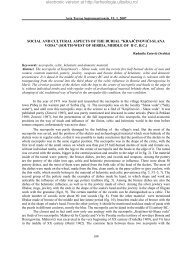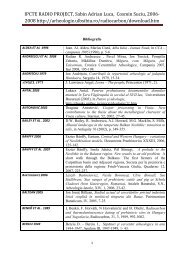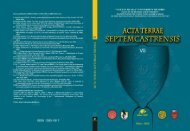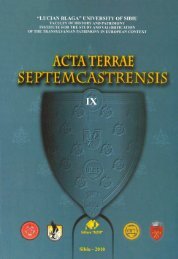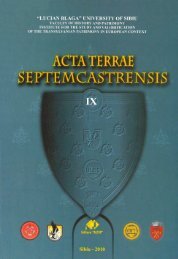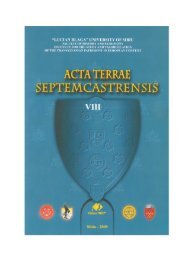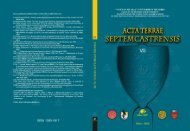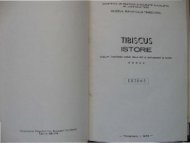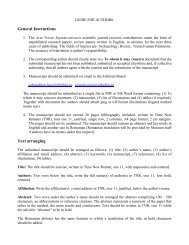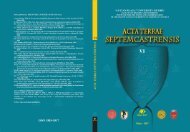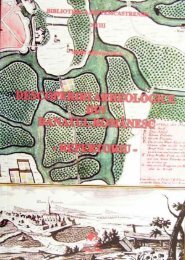acta terrae septemcastrensis viii - Institutul pentru cercetarea Åi ...
acta terrae septemcastrensis viii - Institutul pentru cercetarea Åi ...
acta terrae septemcastrensis viii - Institutul pentru cercetarea Åi ...
Create successful ePaper yourself
Turn your PDF publications into a flip-book with our unique Google optimized e-Paper software.
Acta Terrae Septemcastrensis, VIII, 2009<br />
tables, with walls that are always inscribed. They are followed by spindle-whorls<br />
(24.0%). Inscribed cylinders (16.3%) constitute a distinct feature from Sitagroi.<br />
Anthropomorphic figurines represent 15.5%. When the gender is known, it is<br />
female. However, the presence of statuettes without clear gender attributes is high.<br />
The contribution from dwelling models and potshards is marginal.<br />
Slatino lists 127 signs from the Stamina stage of the Danube script. Human<br />
figurines are the most frequently inscribed artifact (35.4% of the totality of the<br />
signs). They are concentrated in the Gradešnica–Brenica culture and have mainly<br />
asexual features. In 95.6% of the instances, they are inscribed on the front. The<br />
remaining figurines are inscribed on the hips. The Danube script was also<br />
massively present on mignon altars–offering tables (24.3%), even if restrictedly to<br />
the Gradešnica–Slatino I-III assemblage. In all the cases, they bear signs on their<br />
walls. Inscribed potshards rate 14.8%. They occur only in the Gradešnica–Slatino<br />
I-III assemblage and are always from the base-bottom of the pots. The presence of<br />
the script on ovens (7.8%) and mignon vessels (6.1%) was much less. They occur<br />
only in the Gradešnica–Brenica culture and are always from rim/upper body area.<br />
The input from seals (4.3%) and spindle-whorls (3.5%) was much more limited.<br />
Vršac–At gathers a corpus of 117 signs, which occur mainly in the<br />
Blooming stage of the script, in the Vinča C culture. There is additional sporadic<br />
evidence during the Formative stage of the script, in the Starcevo–Cris (Körös) IIIA<br />
phase. Signs occurred primarily on potshards (63.2%). In 48.6% of the instances,<br />
they are inscribed on the rim/upper body area, in 36.1% on the area near the base,<br />
and in 15.3% on the base/bottom. The Danube script was also massively present on<br />
mignon altars–offering tables: 21.9%. They all belong to the Late Neolithic Vinča C<br />
culture. About 76% of the signs are incised on walls, and 34% on legs. Vessels<br />
cluster 8.8%. They all belong to the Vinča C culture and their inscriptions are<br />
restricted to the base-bottom. The contribution from zoomorphic figurines (6.1%) is<br />
less numerous.<br />
The archaeological site located 3 km. northeastwards from the village of<br />
Borovan gathers 111 signs, occurring restrictedly in the Blooming stage of the<br />
script (Gradešnica–Brenica culture). They are massively clustered on human<br />
figurines: 92.8. In 68.0% of the instances, human representations have obvious<br />
female features. In the last instances they are without distinct gender attributes.<br />
The signs occur over a wide range on anatomic parts: chest (28.6%), back (21.4%),<br />
legs (20.0%), abdomen-belly (10.0%), front (10.0%), and hips (2.9%). The human<br />
representations of unknown gender are inscribed restrictedly on legs and hips.<br />
Kurilo contributed 100 signs, all from the Blooming stage of the Danube<br />
script. They are concentrated in the Karanovo IV–Kalojanovec culture of southcentral<br />
Bulgaria. According to Todorova, Kurilo yielded Middle and Late<br />
Neolithic pictograms (Todorova 1986: 210, Pl. 115). The signs are clustered on<br />
human figurines (63.0%). About 60.3% of them have a female gender. The signs<br />
occur over a wide range on anatomical parts: back (44.7%), legs (23.7%), chest<br />
(21.0%), abdomen-belly (5.3%), and sex (5.3%). Anthropomorphic representations<br />
are followed by plate/tablets (17%). Potshards record 15.0%, and are always<br />
inscribed on the rim/upper body area. The input from zoomorphic figurines (4%) is<br />
limited.<br />
49



